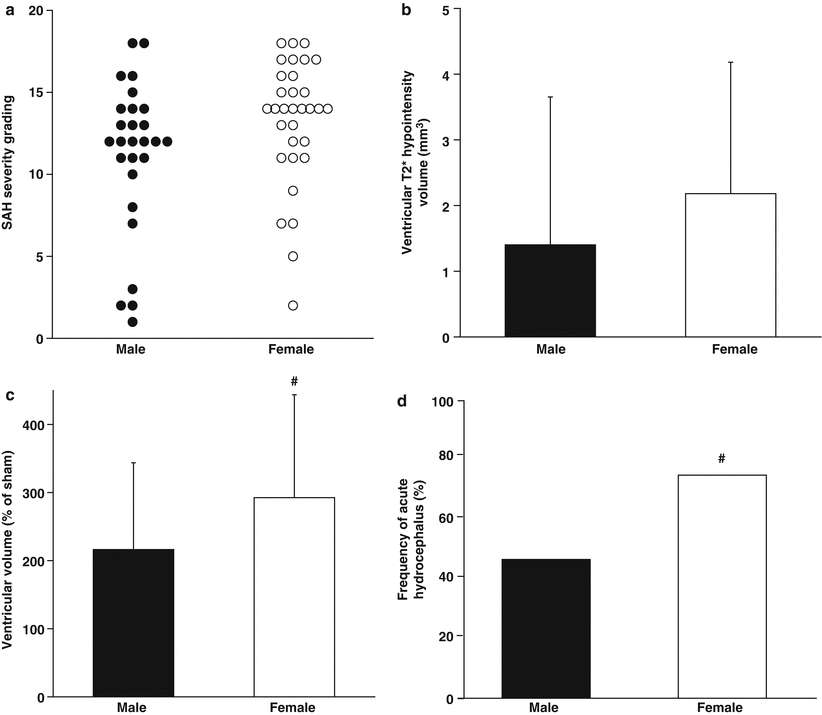Fig. 1
(a, b) Coronal frozen brain sections and T2- and T2*-weighted magnetic resonance images from rats that had (a) sham operation or (b) SAH at 24 h after the procedures. (c, d) Measurement of ventricular volume in T2-weighted MRIs at 24 h after SAH or sham procedure (c) and the correlation between ventricular volume and ventricular T2* hypointensity volume at 24 h after SAH (d). Values are mean ± SD, n = 11–32, # p < 0.001 vs sham group
After SAH, there was no significant difference between genders in mortality rate (females 11/41, 27 %; males 9/41, 22 %; 9/41; p > 0.05), SAH severity grade (females 13 ± 4, n = 32; males 11 ± 5, n = 27; p > 0.05, Fig. 2a) and modified Garcia score (females 14 ± 3, n = 32; males14 ± 3, n = 25; p > 0.5). In addition, the size of ventricular T2* hypointensity lesions (intraventricular hemorrhage) was not different in females (2.2 ± 2.0 mm3; n = 32) and males (1.4 ± 2.2 mm3; n = 30) after SAH (p > 0.05, Fig. 2b).


Fig. 2
(a) SAH severity grades, (b) ventricular T2* hypointensity volumes, (c) ventricular volumes (as a percentage of values in sham-operated animals), and (d) frequency of acute hydrocephalus in male and female rats at 24 h after SAH. Values are mean ± SD, n = 27–32, # p < 0.05 vs male group
In male rats, ventricular volume after SAH (27.7 ± 16.3 mm3; n = 30) was also larger than those in sham-operated animals (12.8 ± 3.8 mm3; n = 11; p < 0.01) as previously described (15). Thus, in both male and female rats, SAH caused ventricular enlargement. However, the relative change in ventricular volume (compared with sham-operated rats) at 24 h was significantly greater in females (292 ± 150 %, n = 32) than males (216 ± 127 %, n = 30; p < 0.05, Fig. 2c). Similarly, the occurrence of acute hydrocephalus (ventricular volume > +3 SD above the mean in sham rats) was markedly greater in females (75 %; 24/32) than in males (47 %; 14/30, p < 0.05, Fig. 2d). These results indicate that gender plays a role in the development of acute hydrocephalus after SAH.
Discussion
Acute hydrocephalus is associated with poor outcome after SAH [6]. Hydrocephalus develops within 72 h (acute hydrocephalus) in 20–63 % of SAH patients but rarely occurs in SAH patients at 3–7 days (2–3 %; subacute hydrocephalus) [9, 10]. It is generally accepted that fibrosis of the leptomeninges and arachnoid granulations cause impaired cerebrospinal flow and decreased absorption, resulting in hydrocephalus development. However, the exact mechanisms of hydrocephalus development after SAH remain poorly understood. In a clinical study, the presence of an intraventricular hemorrhage had a high statistical correlation with hydrocephalus [9] and we found that the degree of hydrocephalus correlated with the amount of intraventricular blood in a rat SAH model [15].
In addition to SAH incidence being higher in women than in men [13], more female patients develop acute hydrocephalus after SAH [19]. Female gender was also one of the parameters associated with the likelihood of needing a permanent shunt [3]. In this study, we examined the effect of gender in experimental rat SAH and found that acute hydrocephalus occurs more frequently in females. In a clinical study, acute hydrocephalus after SAH occurred 2.2-fold more frequently in women compared with men [14]. In another study, female gender was one factor associated with shunt-dependent hydrocephalus [5]. These results all suggest that the gender is the factor in the development of acute hydrocephalus after SAH.
There are some limitations to this study: (1) the time course of SAH-induced hydrocephalus in different genders after SAH was not determined and (2) it is still unknown whether estrogen has a role in hydrocephalus development.
Conclusion
The present study demonstrated that gender impacts acute hydrocephalus development in a rat model of SAH. Future studies should determine the role of estrogen in SAH-induced hydrocephalus.
Acknowledgment
This study was supported by grants NS-073595, NS-079157 and NS-084049 from the National Institutes of Health (NIH). The content is solely the responsibility of the authors and does not necessarily represent the official views of the NIH.
References
1.
Black PM (1986) Hydrocephalus and vasospasm after subarachnoid hemorrhage from ruptured intracranial aneurysms. Neurosurgery 18:12–16CrossRefPubMed
Stay updated, free articles. Join our Telegram channel

Full access? Get Clinical Tree








